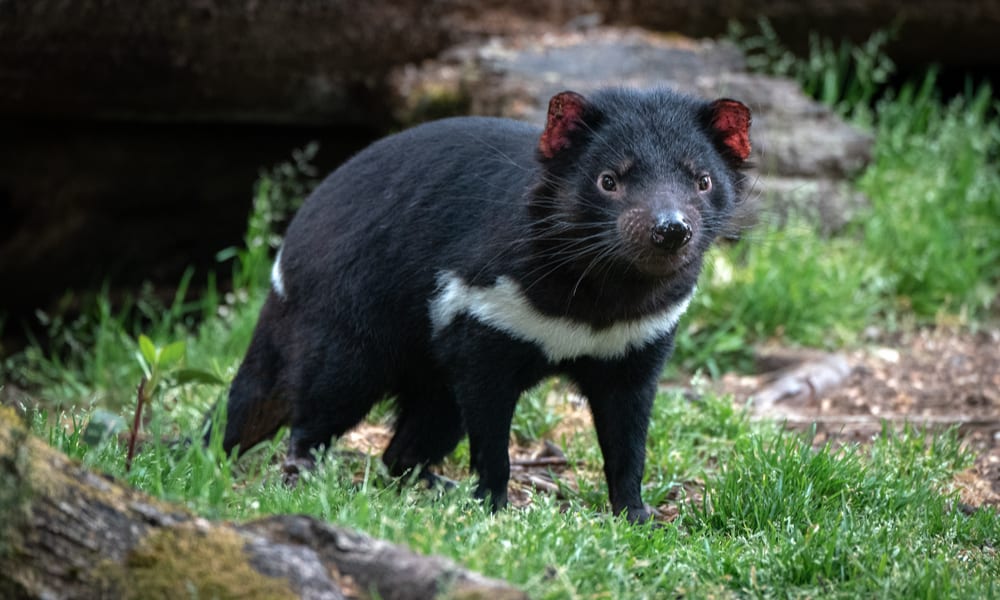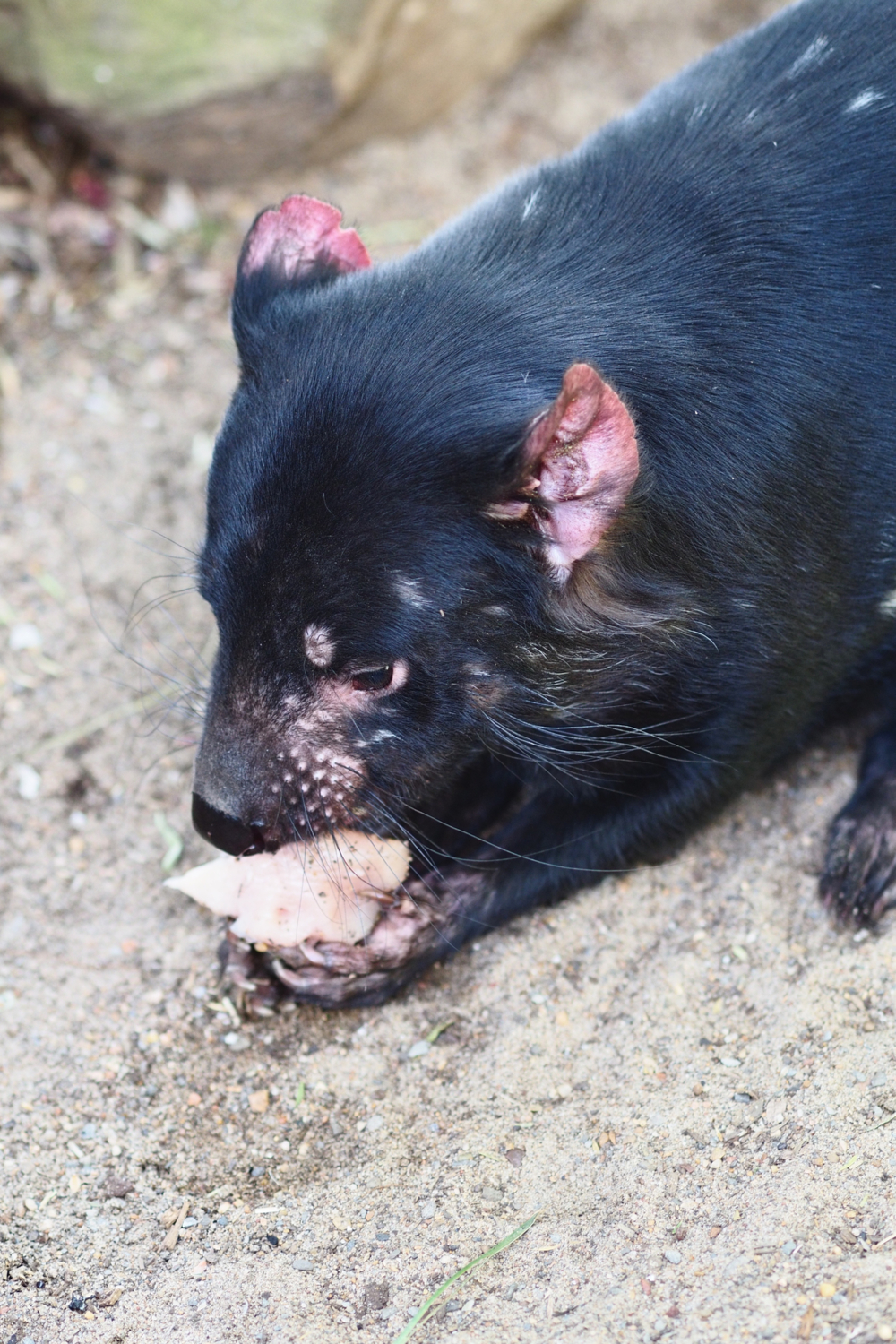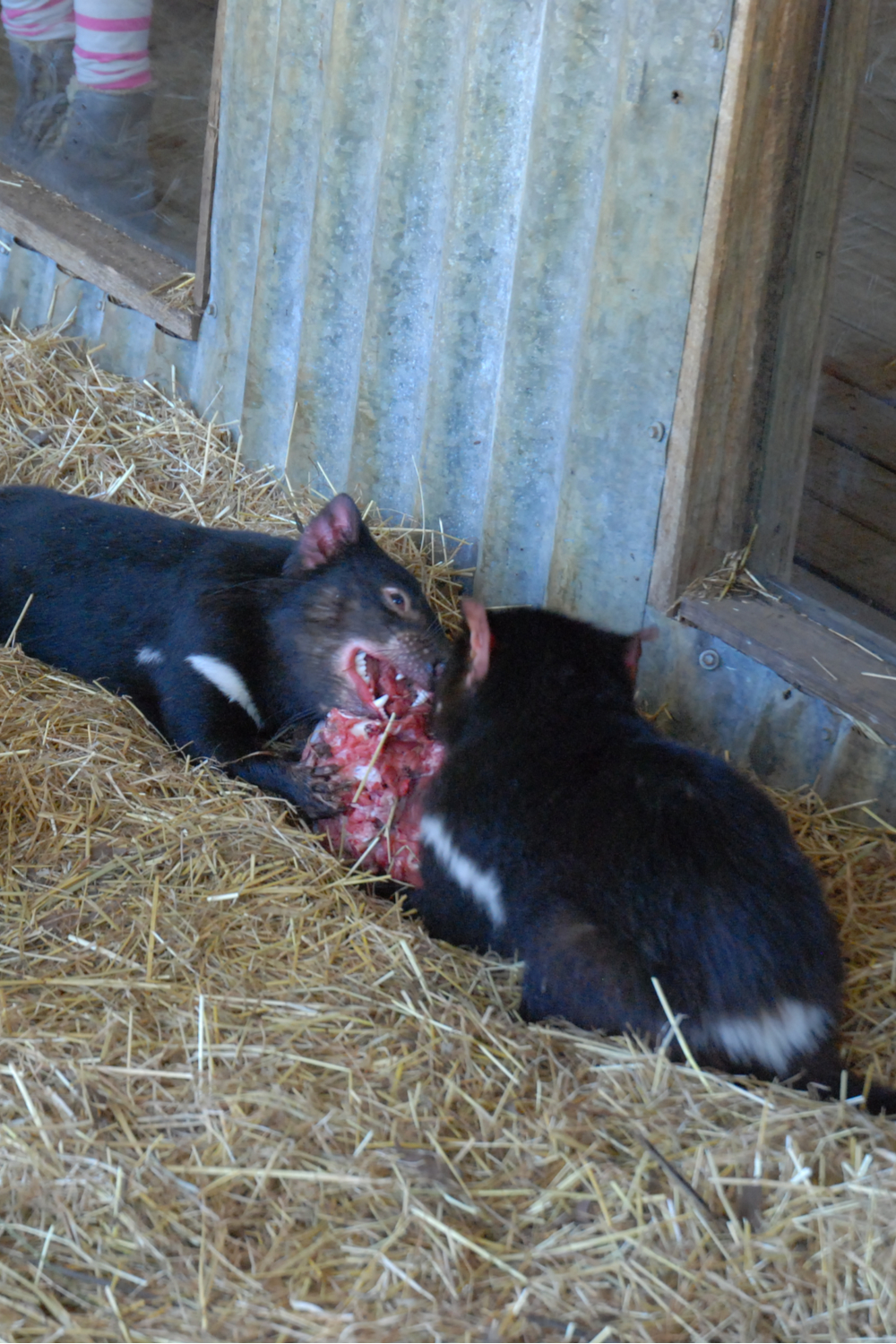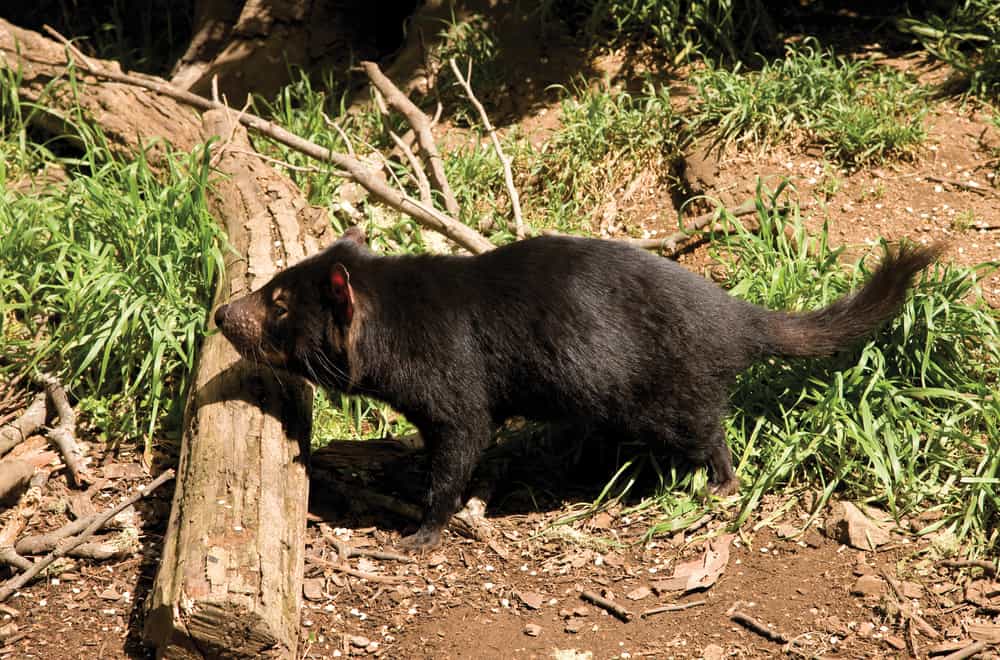If you’ve watched Looney Tunes cartoons, then you must be familiar with the character Taz. Yes. Taz is a character based on an actual animal, the Tasmanian devil. You might mistake them for baby bears at first sight, but they are in no way related.
What do devils’ eat? You’ll have to read on to satisfy your curiosity.
Tasmanian Devils Habits And Biology
The Tasmanian devil, Tasy, or simply devil, is a marsupial that was until recently found only found in the island state of Tasmania. Now, you can also find it in New South Wales and mainland Australia.
The devil is the size of a puppy dog and is the largest carnivorous marsupial (pouched animal) worldwide.
You can easily recognize Tasmanian devils by their muscular build, pungent odor, being annoyingly loud, keen sense of smell, black fur, and ferocious feeding habits.
Despite Tasmanian devils being solitary animals, they often poop together in a common area/location.
Devils are primarily active in the middle of the day without overheating due to their capability to thermoregulate effectively.
Tasmanian devils are capable of surprising speed and endurance despite their chubby appearance. They can also swim across rivers and climb trees.
On their forefeet, devils have five long toes. Four of the devil’s toes point to the front, and one comes out from the side, giving the devil the ability to hold food. In contrast, their hind feet have four toes.
Males are typically larger than females, with a combined head and body length of 653 millimeters, a tail of 258 millimeters, and an average of 8 kilograms in weight.
Females have an average head and body length of 570 millimeters, a tail of 244 millimeters, and an average of 6 kilograms in weight. However, devils of western Tasmania are typically smaller.
Males are polygamous and will have more than one mating partner. They’ll fight each other for females and prevent them from infidelity.
Female devils will give birth to 20-30 live young ones after three weeks of gestation. Their young are pink in color and furless. They weigh about 0.20 grams at birth and stay in their mother’s pouches for a period not exceeding 100 days.
Females have only four nipples and, therefore, suckling young ones have to compete to feed. As a result, only a few newborns survive. Baby devils become independent after nine months. They become fully grown at two years and may live for up to five years in the wild.
What Do Tasmanian Devils Eat In The Wild?
Tasmanian devils are keystone species in the Tasmanian ecosystem. They are primarily nocturnal hunters but are also crepuscular hunters. That is, they are active during the night and slightly before sundown (twilight).
Being carnivorous, they mainly feed on animal matter. Devils can take on preys up to the size of a small kangaroo. However, they are more opportunistic feeders and eat carrion (decaying animal flesh) more than hunt live prey.
Devils will forage on dead fish washed ashore and will also hunt water rats by the sea. Near human habitation, they feed on sheep‘s legs that have slipped in shearing sheds (large sheds built to accommodate large-scale sheep shearing activities).
Tasmanian devils’ diets vary depending on the foods available. The following are the main foods that they eat:
- Wombats –are easy to hunt and have high-fat content that sustains them throughout the day.
- Bettongs, also known as rat kangaroos, are small marsupials occasionally preyed on by devils.
- Wallabies are like miniature-sized kangaroos, native to Australia and New Guinea, often hunted by devils
- Potoroos
- Domestic animals –such as chicken, rabbits, and sheep are eaten when Tasmanian devils invade homesteads
- Birds
- Fish
- Insects
- Tadpoles
- Frogs
- Reptiles
Devils have powerful bites that can bite through metal traps. They usually reserve their powerful jaws for escaping captivity rather than breaking into food storage facilities.
Due to their lack of extreme speed, they cannot chase down prey like wallabies or rabbits. Instead, they target animals that have become slow due to illness.
Tasmanian devils use their keen sense of smell to sniff out sick prey from distances ranging between 10-15 meters away and attack.
Using their forefeet, devils will dig when foraging for corpses. They feed on animals’ dead bodies by first tearing their digestive system because it’s the softest flesh before eating the rest.
Devils eat an average of about 15% of their body weights but can eat up to a maximum of 40% of their body weights in 30 minutes or less if they get lucky! Consequently, they become fatigued and lie down, making them easily approachable by predators.
Devil’s will completely devour all traces of small-bodied carcasses, including the fur and bones. They have earned the nickname Tasmanian farmers because the speed at which they eat carcasses aids in preventing the spread of insects that might harm livestock.
According to studies carried out at Cradle Mountain in Tasmania, male and female diets vary substantially, especially with season changes.
During winter, males prefer medium-sized animals over larger ones, whereas they prefer larger prey in summer. Females are less likely to feed on larger prey.
In winter, large and medium-sized animals account for 25% and 58% of their diets, respectively. Small mammals make up 7%, and birds make up 10% of their diets.
During summer, large and medium-sized animals, birds, and small mammals make up 61% of devil’s diets; 37% are birds and small mammals.
Juvenile devils will climb trees to eat bird eggs and grub. They may even climb into nests to capture birds.
Devils mainly hunt alone, but there have been claims of group hunting, where they drive prey off its habitat before others join in the attack.
Facts About Tasmanian Devils
- Tasmanian devils are shy, get easily frightened, and don’t pose a threat to human beings. But when cornered or attacked, they become fierce. When feeling threatened, they do a strange yawn that may seem ferocious but is a sign of fear.
- In 2008, Tasmanian devils were listed as endangered species. The primary cause of their decline in number is being hit by cars when trying to get roadkill. Moreover, they are prone to a facial tumor that stops them from eating.
- Tasmanian Devils’ like dogs have 42 teeth, but unlike them, devils’ teeth never stop growing.
- Baby devils’ (joeys) are the size of a rice grain at birth. As previously mentioned, female devils’ give birth to about 30 joeys, which have to race to their mother’s pouch, with only four tits.
- Tasmanian devils will sleep inside the carcasses of their prey. They do this so they can continue eating when they wake up.
- Similar to hyenas, devils’ have powerful bites that can crush human bones. They can open their massive jaws up to 80o
- They store fat obtained from food in their tails. A distinctively thick tail is a sign of good health.
- Devils produce loud, disturbing screams. They are called devils because of the sounds they make – strange sounds, such as screeches, sneezes, growls, snorts, and coughs to scare off other animals.
- Their scientific name, Sacrophilus harrissi, comes from the scientist who first described the Tasmanian devil. According to the Tasmanian government fact page, the animal name means “Harris’s meat lover.”
- The Tasmanian devil is the inspiration behind the Looney Toon cartoon character Taz, portraying the animal’s behavior.
- They use their acute sense of smell and long whiskers to avoid predators and locate carrion and prey.
- In the 1850s, devils were displayed in a variety of zoos worldwide.
- In 2005 the Tasmanian government gifted four devils (two males and two females) to the Copenhagen Zoo, following the birth of the son of the Crown Prince of Denmark, Frederik, and Mary, his Tasmanian-born wife.
- In Australia, the devil is an iconic animal. It has appeared on several collectible coins in Australia, which can also be used as currency.
- Tasmanian devils are used as the symbol of the National Parks and Wildlife Service of Tasmania.
- Devils are nicknamed Australian hyenas because of their strong teeth and scavenging habits.
- When they gather to feed, they can be extremely noisy, whereby you could hear them from several kilometers away.
Frequently Asked Questions (FAQ)
Which animals prey on Tasmanian devils?
Tasmanian devils face threats from other predators, such as foxes and wild dogs. Their most significant predator is the Tasmanian wedge-tailed eagle which competes for food with the devils.
The Tasmanian wedge-tailed eagle will also attack devils’ babies if left unattended.
Can you keep a Tasmanian devil as a pet?
No. Tasmanian devils thrive in the wild, where they roam around for miles in search of food. They are also solitary animals, meaning they prefer to be alone.
Can Tasmanian devils kill human beings?
No, devils are incapable of killing humans. Despite their reputation for aggression, they try as much as possible to avoid interacting with humans. However, it might attack when backed to a corner, delivering a powerful bite that can cause serious injury.
Which predator would win between a Tasmanian devil and a wolverine?
In a one-on-one scenario, the wolverine would win the battle. Wolverines possess sheer ferocity and power. The devil might be able to land a solid bite or two, but it won’t be enough to win the brawl.
Summary
Tasmanian devils are crucial in maintaining the Tasmanian ecosystems. Despite their intimidating look, they are very shy and reserved creatures. Don’t be fooled by their small sizes because they can be ferocious when the need arises.
We hope this article on “what do Tasmanian devils eat” has been beneficial to you.



